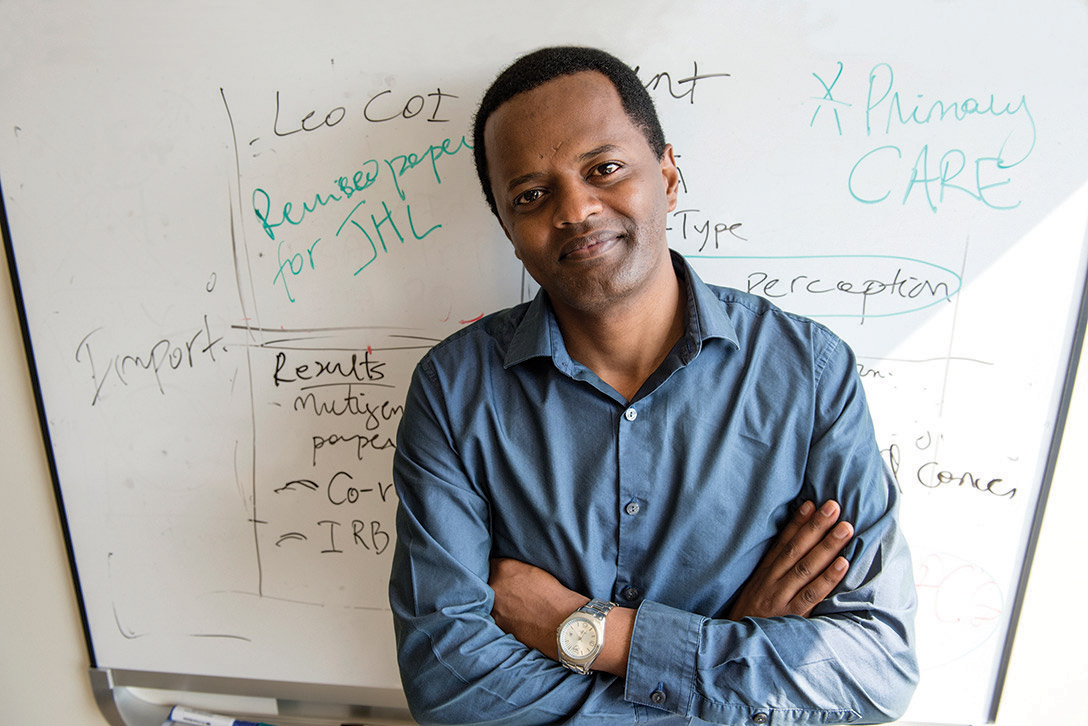
Spreading healthcare through collaboration
Zelalem Haile, assistant professor of epidemiology in the Department of Social Medicine at OHIO’s Heritage College of Osteopathic Medicine at Dublin, relies on teamwork to advance global health; sexual and reproductive health; and maternal, infant, and child health.
By Peter Szatmary | December 19, 2016
Share:

Sample articles co-written by Zelalem Haile, MPH ’09, assistant professor of epidemiology in the Department of Social Medicine at OHIO’s Heritage College of Osteopathic Medicine at Dublin: “Gender Roles and Perceptions of Malaria Risk in Agricultural Communities of Mwea Division in Central Kenya” (Journal of Women & Health, March 2015) and “Adolescent Pregnancy and Smoking in West Virginia: Pregnancy Risk Assessment Monitoring System 2005–2010” (Maternal and Child Health Journal, July 2016). Photo by Margo Sabec, MA '17
“Epidemiology, the study of the distribution and control of diseases, involves gathering information about large groups of people. Designing, measuring, and analyzing data require input from co-investigators, researchers, assistants, students, and so on,” he explained. “This collaboration promotes innovation and broadens ideas when identifying health-related problems and developing appropriate interventions.”
Haile, MPH ’09, answered questions about his career and background via e-mail. Edited excerpts follow. —Editor Peter Szatmary
You research breastfeeding. Covering what?
The influence of gestational diabetes and gestational weight gain on initiation, duration, and frequency of breastfeeding among women in the United States. In one study, we found that women with gestational diabetes and women with inadequate gestational weight gain were less likely to breastfeed exclusively at hospital discharge.
You also monitor contraception in Tanzanian women.
Our recent study determined that women who used oral contraception were less likely to have iron deficiency, anemia, and iron deficiency anemia. I am now exploring the relationship between other hormonal contraception and these outcomes.
Your scrutiny of HIV?
I am collaborating with OHIO faculty on two studies examining, respectively, HIV risk perception among students at a Midwest university and the association between substance abuse and HIV among urban slum dwellers in Kenya. I also received funding from Heritage College’s Research and Scholarly Awards Committee to study biomarkers of disease progression among HIV patients in Ghana—a first for that country.
Your audit of African immigrant populations in the U.S.?
Collaborating with OHIO faculty, I am collecting data examining knowledge, perception, and utilization of cervical cancer screening and HPV vaccination among Somali immigrant/migrant youth in the Columbus area.
OHIO is one of the few universities nationwide with a social medicine department that unites medical ethics, medical history, public health, and epidemiology. The significance?
A social medicine department exposes students to the complexities of the social factors influencing health and encourages clinicians and faculty to collaborate on wide-ranging projects. It’s a wonderful platform.
You hail from Addis Ababa, Ethiopia. You earned a bachelor’s degree in anthropology and archaeology from University of Asmara, Eritrea, a master’s degree in anthropology from University of Florida, a master of public health from OHIO, and a doctorate in epidemiology from West Virginia University. What brought you to OHIO—and back?
After graduating from University of Florida, I taught anthropology for about three years at Asmara University. I had opportunity to participate in public health projects while there and decided to further my studies in the field and enrolled at OHIO. After my MPH, I worked as a coordinator for the University’s African Health Initiative for almost two years. Then I decided to go for my PHD. The OHIO pull was strong enough that afterward I wanted to return. The collaborative culture and family-like environment among students and faculty here are qualities I have been fortunate to experience.
Something most people don’t know about you?
I am an avid fan of Arsenal, the English professional soccer team in the Premier League. I love playing soccer, too.
Your teaching in clinical prevention and population health encompasses epidemiology, biostatistics, preventive medicine, and evidence-based medicine. Summarize the importance of this breadth.
These topics provide students with tools necessary to integrate population health principles in the prevention of diseases, promotion of health, and improvement of health outcomes.
The past two summers you’ve been part of OHIO’s Global Health Initiative in Botswana.
I’ve helped train participants from the Ministry of Health, the National AIDS Coordinating Agency, and the Institute of Health Sciences. I always say that contributing some of my time in Botswana is like one gear in a watch. The watch will not work unless all components function together.
Think of popular culture representations of epidemiology—in novels, movies, plays, TV shows, etc. Do any get it more or less right? Or, perhaps as memorable in an inverse way, do any depict it very, very wrong?
The creators have gotten better at doing their research about the issues involving epidemiologists and other health professionals. The 2011 movie Contagion is an example that shows the prevention of contagious or infectious diseases with unique etiologies, the nature of the work in the labs, and the impact on communities, and, subsequently, society. It is also not easy to put all necessary information in a running time of less than two hours. Likewise, it might not be too interesting to read in a novel the details of the epidemiologic investigations involved from disease detection to disease containment to disease elimination.
Your experiences on the Athens Campus and the Dublin Campus?
One thing the sites share in common is that they both promote the idea of a close-knit, family-like environment. One difference is that Athens is a small college town with so many students that sometimes you feel like you live with them. This is a benefit for the students, though—to have their instructors in proximity, thus building strong relationships. Dublin, on the other hand, boasts of its expanding and sprawling businesses. It also has great greenery and parks, just like Athens. I get a taste of both worlds because in my work in Dublin, I frequently travel to Athens.




